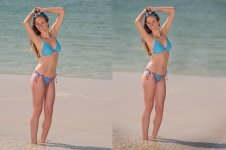I got a PM last night from a fellow Nikonite in response to a comment I made about blurring the background on the following thread:
http://nikonites.com/photo-feedback/36518-how-can-i-improve-photo.html#post559067
I mentioned that since it was just a "quick and dirty" recommendation I just blurred the background in a couple of progressively blurred blocks instead of using layer masks. I was asked if I could give a quick tutorial on how to do it the "right" way using layer masks (actually alpha channels). It is not all that difficult a process (though it is a little time consuming), though it may seem like it the first time if you are unfamiliar with using masks, but if there is enough interest I can put something together and post it here. Here is an image I did just for this thread. It too is a little "quick and dirty". It is an image I pulled off the web because it seemed like an easy one to try. The process took me about 12 minutes or so, the longest probably doing a careful selection of the subject (which is very important).
Of course you should strive to get things right in the camera so you don't have to do a lot of PS work afterwards but it is always nice to know it is there. I know depth of field control is more difficult with crop sensor cameras because your focal lengths are shorter for the same magnification as FX. When doing outside portraiture, I always use either my 105mm f/1.8, 180mm f/2.8 or even my 300mm f/2.8 one stop down to get the shallowest DoF possible. This PS thing is not a perfect simulation of what shallow depth of field looks like using just aperture, but it is pretty close. As you can see in the image, it makes a HUGE improvement in the aesthetics of the image. No sharp horizon going through the middle of her head.

http://nikonites.com/photo-feedback/36518-how-can-i-improve-photo.html#post559067
I mentioned that since it was just a "quick and dirty" recommendation I just blurred the background in a couple of progressively blurred blocks instead of using layer masks. I was asked if I could give a quick tutorial on how to do it the "right" way using layer masks (actually alpha channels). It is not all that difficult a process (though it is a little time consuming), though it may seem like it the first time if you are unfamiliar with using masks, but if there is enough interest I can put something together and post it here. Here is an image I did just for this thread. It too is a little "quick and dirty". It is an image I pulled off the web because it seemed like an easy one to try. The process took me about 12 minutes or so, the longest probably doing a careful selection of the subject (which is very important).
Of course you should strive to get things right in the camera so you don't have to do a lot of PS work afterwards but it is always nice to know it is there. I know depth of field control is more difficult with crop sensor cameras because your focal lengths are shorter for the same magnification as FX. When doing outside portraiture, I always use either my 105mm f/1.8, 180mm f/2.8 or even my 300mm f/2.8 one stop down to get the shallowest DoF possible. This PS thing is not a perfect simulation of what shallow depth of field looks like using just aperture, but it is pretty close. As you can see in the image, it makes a HUGE improvement in the aesthetics of the image. No sharp horizon going through the middle of her head.

Last edited:


